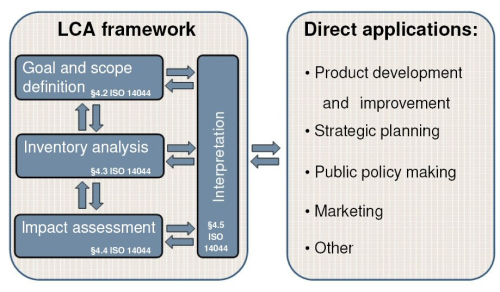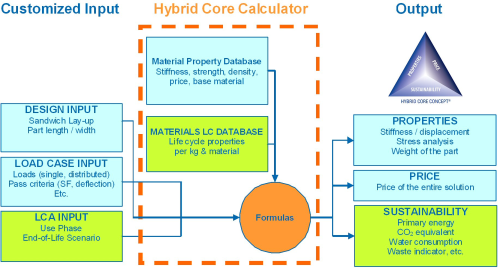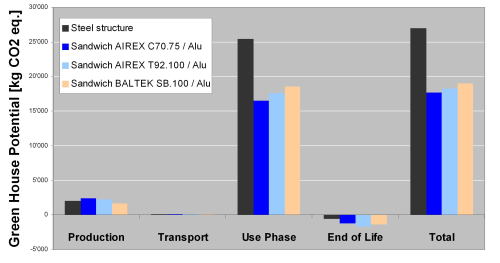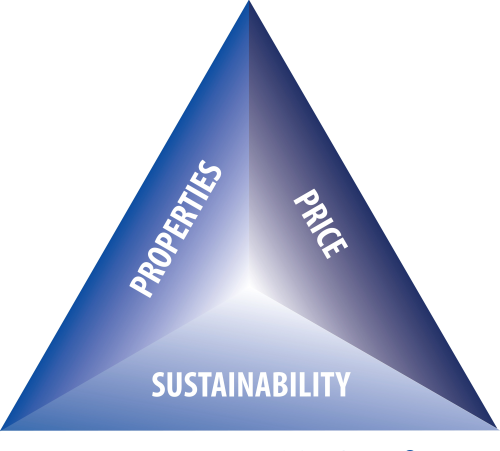





Decision makers already dealing with different requirements for sandwich applications, such as optimal mechanical and physical properties or price, are now confronted with another dimension to their decision: the environment. Questions such as “What ecological impact will a product have once it has finished its service life?” or “How can the ecological impact be reduced?” are essential in this discussion. The answer to a lot of these questions is life cycle analysis or life cycle assessment.
According to the ISO 14040 standard (Environmental management - Life cycle assessment - Principles and framework): “Life cycle assessment is the compiling and evaluation of the input and outputs and the potential environmental impacts of a product system during its lifetime.”
The framework of life cycle assessment consists of four process steps (Figure 1):
- goal and scope definition (§4.2 ISO 14044);
- inventory analysis (§4.3 ISO 14044);
- impact assessment (§4.4 ISO 14044); and
- interpretation (§4.5 ISO 14044).
After the goal and scope of a life cycle assessment study are defined, the data collection and description of the inventory starts – life cycle inventory analysis (LCI). The next step is a life cycle impact assessment that identifies and appraises the amount and significance of the potential environmental impacts of a product or system. To do so, LCI results are classified into categories according to their different impacts and measurement units (e.g. Global Warming Potential measured in carbon dioxide/CO2 equivalents.)
On the basis of the inventory results and the impact assessment the analysis and interpretation of the study is finally performed. These are the fundamentals for further discussions or system optimisation.
The Hybrid Core Calculator
The Hybrid Core Calculator is a powerful tool to perform a simplified life cycle assessment based on ISO 14040. Life cycle data for the most common sandwich skins and core materials have been collected to calculate the environmental footprint of a sandwich structure. As shown in Figure 2, environmental impacts are calculated for each phase of a product’s life cycle and measured in:
- primary energy consumption (MJ);
- greenhouse potential (CO2 equivalents);
- water consumption (litres); and
- other ecology indicators.
The starting point for the calculation is always customised input with regard to the sandwich design (length, width, lay-up) and the loads that will be applied to the structure. Also important for the calculation is information about the future use and disposal of the structure. In combination with a comprehensive material property database an LCI database was developed for all the materials used to build a sandwich. A detailed analysis of the 3A Composites processes has been performed, supplemented by publicly available data from commercially available databases for the raw material production of the input materials and the materials not produced at 3A Composites. Publicly available data was also used for the end-of-life phase.
The Hybrid Core Calculator can then determine environmental impact values for the given structure as well as related price and physical properties that apply to the materials chosen for the sandwich calculation. Thus, the sandwich structure can be optimised to the maximum. The aim of the Calculator is not to determine an absolute value of the impact, but to allow for comparison of different design options. Figure 3 is a schematic representation of the Hybrid Core Calculator.
Optimisation example
In the following, an optimisation example for an upper floor section of a double-decker bus (Figure 4) is shown. It illustrates how the environmental footprint of a structure can be improved with 3A Composites’ Hybrid Core Calculator.
Example: Optimisation of an upper floor section of a double-decker bus
Scenario:
- double-decker city bus;
- lifetime mileage 800 000 km;
- fuel consumption 40 litres/100 km;
- end-of-life scenario recycling;
- total bus weight 15 tonnes;
- steel upper floor 560 kg;
- alternative sandwich floor approx. 360 kg.
Dimensions of upper floor section:
- length 11.2 m;
- width 2.4 m.
Figure 5 shows the greenhouse potential for several design options as one measurable environmental impact (primary energy, water consumption, etc. are not shown in this chart). The most critical impact is the use phase, which is highly influenced by the vehicle’s weight.
In comparison to the steel floor, a sandwich design can reduce the floor‘s weight by some 30%. The chart also shows that in this ‘use-phase-intensive‘ application this weight reduction results in a considerable 30% reduction of the floor‘s ecological impact over the lifetime of the bus. A composite sandwich construction is therefore not only lighter but also much more sustainable.
Another conclusion of this study is that changing the type of core material can also influence the environmental impact of a sandwich structure. In this case, AIREX® C70.75 would be the alternative with the lowest overall ‘carbon footprint‘ because it is the lightest in weight. However, the biggest weight saving in this example, and thus the biggest impact, comes from substituting the steel structure with a lightweight sandwich structure.
Key insights of the life cycle assessment:
- The life cycle assessment always comprises the total life of a product from cradle (production) to grave (end-of-life).
- Each application has to be analysed in its specific circumstances, especially regarding the use phase and the end-of-life scenario.
- If the use phase is energy-intensive, the ecological impact of production, transport, and end-of-life may become negligible. In such an application, light weight and energy efficiency are key drivers.
- Depending on the point of view (energy, CO2 equivalents, water usage, focus on end-of-life etc.), different material selections may be favourable.
- Every kg of a product: uses raw materials; needs to be transported; may consume energy during the product’s use phase (bus); requires incineration/landfill/recycling.
- Every kg of a product in motion that can be saved improves a product’s ecological footprint.
Sustainable product design
The Hybrid Core Calculator can generate added value by helping customers to make a choice for the most sustainable material combination with regard to their specific design requirements. Thus, sustainability becomes the third dimension in 3A Composites’ Hybrid Core Concept® along with the two other optimisation criteria of physical properties (weight, stiffness, strength) and price (Figure 6). This means that customers can tailor their sandwich solution to their very specific requirements and thus get a sustainable product design that has superior technical properties at optimised cost.
This feature was published in the July/August 2010 issue of Reinforced Plastics magazine.
If you would like further information about any of the issues covered in this feature please e-mail us.






